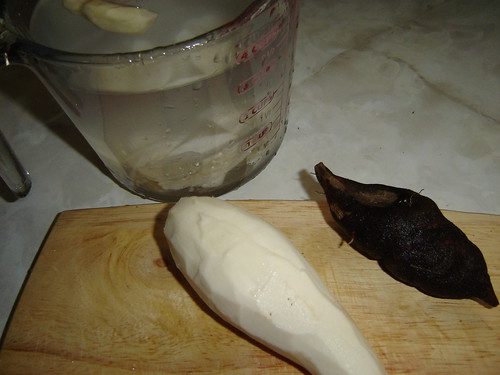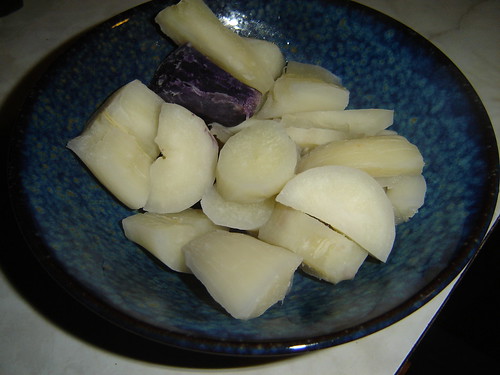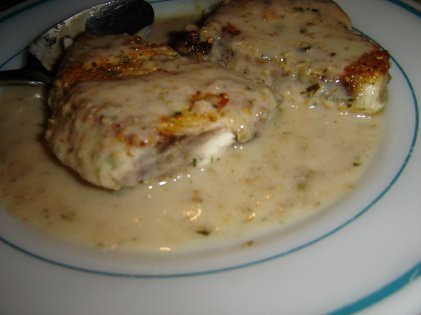 We think the pia (also known as tapioca, manioc, cassava) came with the pigs who wandered on and off our land before it was fenced, before we had a dog. They love the plant, and broken bits took root here and there. Now we have one remaining patch which needs better cultivation, as passion fruit vines are growing around and over it, making the tubers difficult to harvest.
We think the pia (also known as tapioca, manioc, cassava) came with the pigs who wandered on and off our land before it was fenced, before we had a dog. They love the plant, and broken bits took root here and there. Now we have one remaining patch which needs better cultivation, as passion fruit vines are growing around and over it, making the tubers difficult to harvest.Pia is frequently misidentified in Hawaiiana books as "arrowroot", which is a term often used in a generic sense. It is not the Arrowroot plant I am talking about here.
I've used pia only occasionally over the years, but have been doing a bit more research into the plant as part of my ongoing desire to eat more food actually grown by me or produced locally. As far as starches go, I've only just become aware of the prevalence of manioc or pia consumption. Cassava is the third largest source of carbohydrates for human food in the world. Why eat potatoes (which don't do well at our elevation)? We're now growing taro, sweet potatoes, breadfruit, tapioca, and more recently, cooking banana. That about covers the carbs.
This week, before even reading that the leaves die back when the roots are ready, I decided pia would be the perfect accompaniment for my Ono (Wahoo) in Coconut Cream sauce. I manaaged to find a few medium size tubers and got a sweet potato with them. As you see below.

Here I'm cutting the peeled tubers into chunks and then soaking in water until ready to cook. The raw leaves and roots contain toxins (cyanogenic glucosides) in this case, as does taro, which need to be removed prior to eating. I usually cover with water, bring to a boil, then pour off and repeat the process about 3 times, cooking til tender on the last boil.

Nothing fancy here, just the boiled pia, and lonely sweet potato, but served with Ono in Coconut Cream Sauce, fantastic.
Ono in Coconut Cream Sauce
Dump the following onto a piece of waxed paper and mix:3-4 kaffir lime leaves, minced as fine as humanly possible (or in a machine)
3 Tablespoons Spelt flour
2 tablespoons Garlic Gomasio (contains sesame seeds, sea salt & garlic) or salt to taste
pepper to taste
2 fillets Ono (Wahoo)
Coat the fillets of Ono on both sides with the dry mixture.
Heat a skillet and add1 tablespoon ghee or olive oil. Fry the fish fillets at a fairly high heat for several minutes on each side, until just barely done, then remove to a plate and set aside.
Turn the heat off and allow skillet to cool slightly. Add 1 cup white wine to the pan (carefully) turn heat back up to high and reduce by about half, then add 1/2 cup coconut
milk (thick) and stir well, sprinkling in some of the remaining dry seasoning mix, stirring all the while. When it has thickened enough, pour over the fish and serve with your pia (or potatoes or rice).

There it is, that crusty, tangy coating in the creamy sauce is unbeatable in my humble opinion. Ono in Hawaiian means good, and it certainly is.

4 comments:
You should write a book.
That's awesome that you can grow all these starches yourself. I sometimes dream of moving to warmer climes where I could grow my own food.
That looks really delicious! In Hawaii do you use the Taro leaves as a vegetable as well? I remember a wonderful holiday in Samoa when I was a child when I got hooked on taro leaves cooked like spinach in coconut cream.
Yes, some varieties are grown more for the leaves and some are valued more for the roots, but both can be eaten on all. They have more oxalyic acid than spinach though. Have to be rinsed after bringing to a boil, then fresh water, two or three times, depending on the variety.
Post a Comment